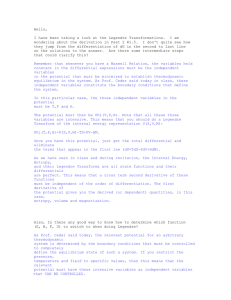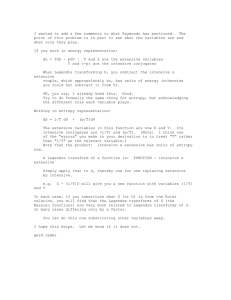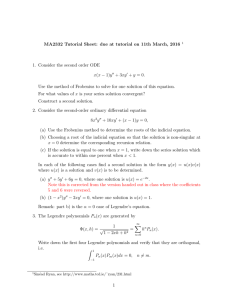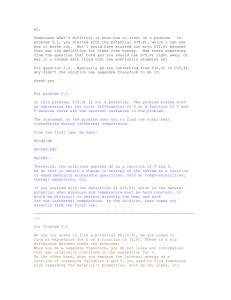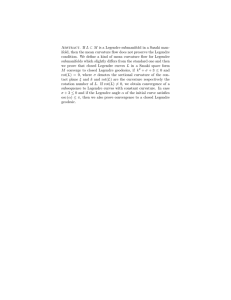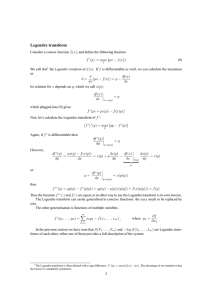Problem Set 2 3.20 MIT Professor Gerbrand Ceder Fall 2003
advertisement
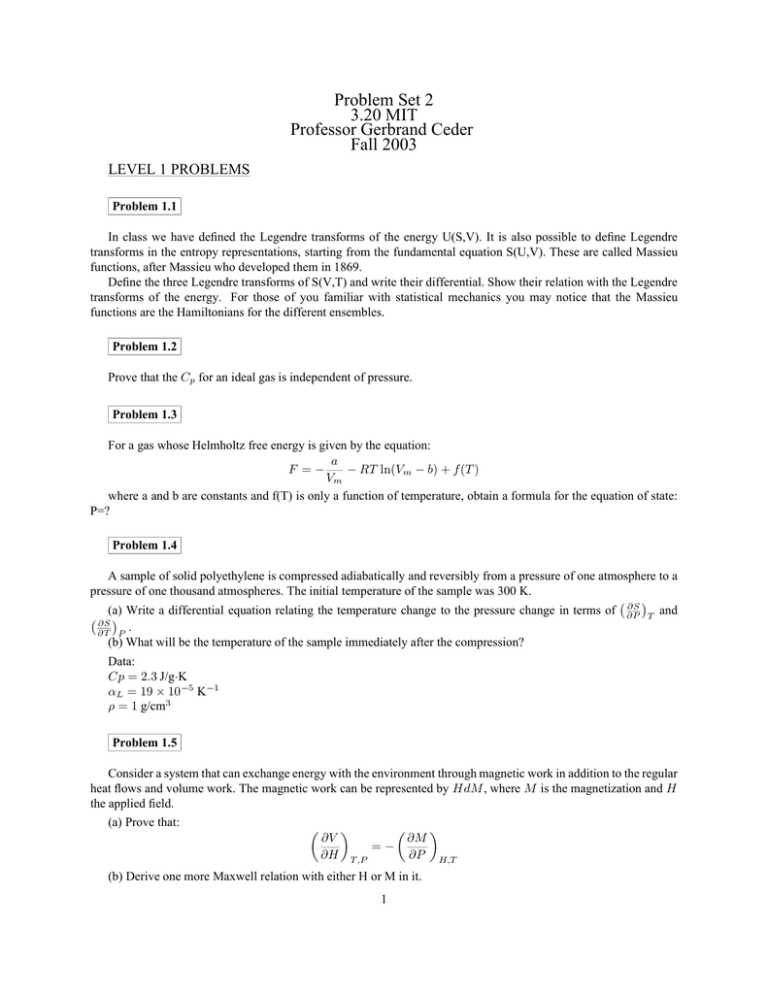
Problem Set 2 3.20 MIT Professor Gerbrand Ceder Fall 2003 LEVEL 1 PROBLEMS Problem 1.1 In class we have defined the Legendre transforms of the energy U(S,V). It is also possible to define Legendre transforms in the entropy representations, starting from the fundamental equation S(U,V). These are called Massieu functions, after Massieu who developed them in 1869. Define the three Legendre transforms of S(V,T) and write their differential. Show their relation with the Legendre transforms of the energy. For those of you familiar with statistical mechanics you may notice that the Massieu functions are the Hamiltonians for the different ensembles. Problem 1.2 Prove that the Cp for an ideal gas is independent of pressure. Problem 1.3 For a gas whose Helmholtz free energy is given by the equation: a � RT ln(Vm � b) + f (T ) F =� Vm where a and b are constants and f(T) is only a function of temperature, obtain a formula for the equation of state: P=? Problem 1.4 A sample of solid polyethylene is compressed adiabatically and reversibly from a pressure of one atmosphere to a pressure of one thousand atmospheres. The initial temperature of the sample was 300 K. � ∂S (a) Write a differential equation relating the temperature change to the pressure change in terms of ∂P and T � ∂S . ∂T P (b) What will be the temperature of the sample immediately after the compression? Data: Cp = 2.3 J/gK L = 19 10�5 K� 1 = 1 g/cm3 Problem 1.5 Consider a system that can exchange energy with the environment through magnetic work in addition to the regular heat flows and volume work. The magnetic work can be represented by HdM , where M is the magnetization and H the applied field. (a) Prove that: ∂V ∂M =� ∂H T ,P ∂P H,T (b) Derive one more Maxwell relation with either H or M in it. 1 Problem 1.6 If a rubber band is stretched, the reversible work is given by ∂W = dL where is the tension on the band and L is the length. (a) If the stretching is carried out at constant pressure and the volume of the band also remains constant during expansion/contraction, derive a thermodynamic function (G) which is a function of L and T . (b) Show that ∂ ∂T =� L ∂S ∂L T (c) Derive the following from thermodynamic principles: ∂U ∂S ∂ = +T = �T ∂L T ∂L T ∂T L (d) For an ideal gas, U is a function of T only, and as a result it can be shown that 1 ∂P 1 V = P ∂T T Show that a corresponding equation exists for an ’’ideal’’ rubber band. LEVEL 2 PROBLEMS Problem 2.1 The pressure on 500g of copper is increased reversibly and isothermally from 0 to 5000 atm at 298 K. (Take the density = 8.96 103 kg/m3 , volume expansivity = 49.5 10�6 K�1 , isothermal compressibility = 6.18 10�12 Pa�1 , and specific heat cp = 385J/kg K to be constant). (a) How much heat is transferred during the compression? (b) How much work is done during the compression? (c) Determine the change of internal energy. (d) What would have been the rise of temperature if the copper had been subjected to a reversible adiabatic compression? Problem 2.2 dU can be expressed in terms of changes in T and P though this contains less information than the combined first and second law, where dU is expressed in terms of dS and dV . Prove that: dU = (Cp � P V )dT + V (P � T )dP Problem 2.3 Do you think that the enthalpy of evaporation of a material is pressure dependent? Comment on the conditions under which it is pressure dependent. 2 Problem 2.4 The fundamental equation for a system with extensive variables S and X is given as U (S, X ) = X �a exp(bS ) Find the functional forms of the following thermodynamic potentials by Legendre transforms: D(S, f ), F (T, X ), K (T, f ) T is the conjugate variable to S and f is the conjugate variable to X. Problem 2.5 Prove the following: (a) (b) ∂S ∂P (c) T cp �V T = V ∂T ∂P ∂ 2P ∂T 2 = S T V cp = V ∂cV ∂V T Problem 2.6 Evaluate � ∂G ∂T V and � ∂H ∂T P for an element in terms of functions measured or tabulated. Problem 2.7 The van der Waals equation of state for an imperfect gas is a P + 2 (V � b) = RT V where a and b are two constants independent of temperature. � � ∂U (a) Calculate the expressions of ∂P , ∂V T , and the isothermal compressibility . ∂T V � (b)Assume now that a = 0 and calculate the coefficient of thermal expansion, , ∂H , and the difference ∂P T Cp � Cv . Problem 2.8 Show that for a single component system for which P V k is constant in an adiabatic process (k is a positive constant) the energy is PV k 1 U= P V + Nf k�1 Nk where f is an arbitrary function. (Hint: P V k must be a function of S so that � ∂U ∂V S = g(s) V �k where g(s) is an unspecified function.) 3 Problem 2.9 Evaluate the thermal expansivity at absolute zero for a substance obeying the third law. (Hint: According to the third law, S approaches the same value for all ordered�states of a substance. The limiting S ∂S =0 value is not only independent of the crystallite structure but also of the pressure. ∂P T =0 Problem 2.10 a) Describe accurately the concept of adiabatic demagnetization. Use equations or pictures if needed. � ∂T H , express ∂H b) For a paramagnetic material that obeys the Curie Law, M = V in terms of the Curie T S constant, the heat capacity under constant field and other fundamental properties of the material. c) Does the temperature increase or decrease when a magnetic field is applied adiabatically ? Explain. LEVEL 3 PROBLEMS Problem 3.1 (a) Find the three equations of state for a system with the fundamental equation R$ $ U = S2 � V2 R V02 and show that % = �U (where $, R, and V0 are positive constants) (b) Express % as a function of T and P for the system. (Hint : U = N. 1 U (S, V, N ) N with N = number of moles in the system and % is an intensive parameter with conjugate Problem 3.2 A long rod of length l and diameter A is held clamped between two rigid walls. Find the heat capacity of the material under these conditions in terms of the unclamped constant pressure heat capacity and fundamental parameters of the system such as compressibilities, thermal expansion and elastic constants. You may assume that the material is isotropic in its elastic and thermal properties. Problem 3.3 A box at constant volume and in thermal equilibrium with the environment contains an internal partition which separates two A-B liquid solutions with different concentrations of A. The internal partition has the remarkable property that its displacement ((V ) and the flow of A species through it are coupled by the relation (V = K(nA . The partition is diathermal (lets heat through) and is impermeable to B. Define the equilibrium criterium for A in terms of its chemical potential and the pressure on each side. Explain reasoning and show derivation. Problem 3.4 A simple system is enclosed in an elastic balloon which expands under increased pressure exerted by the system so that V � aP remains constant. Find the heat capacity under these conditions in terms of the basic properties of simple systems (Cp , V , T , etc.). 4
